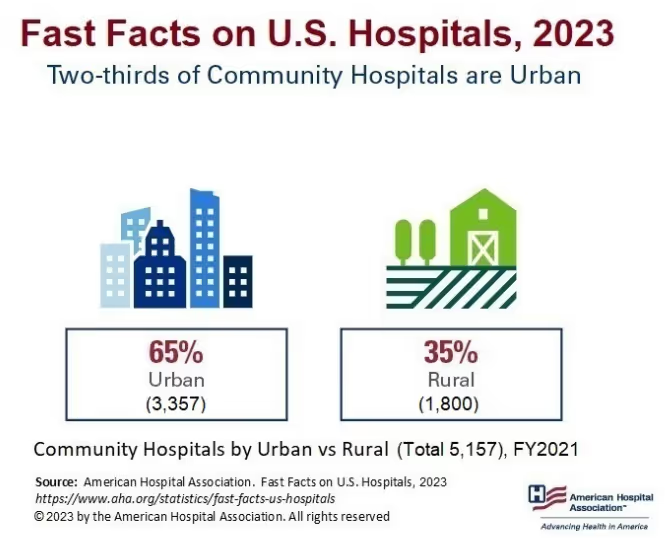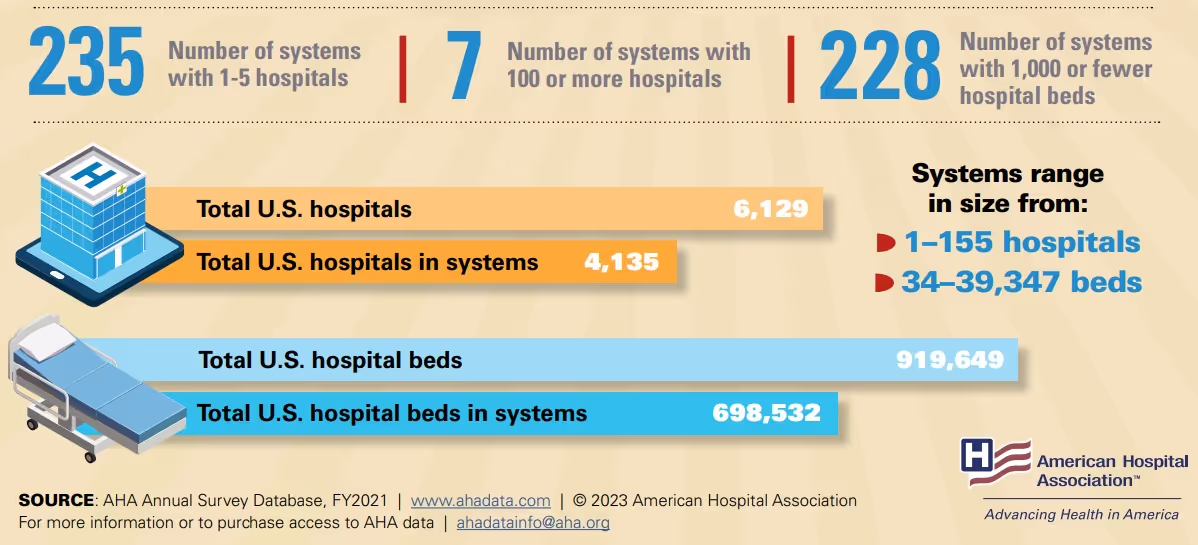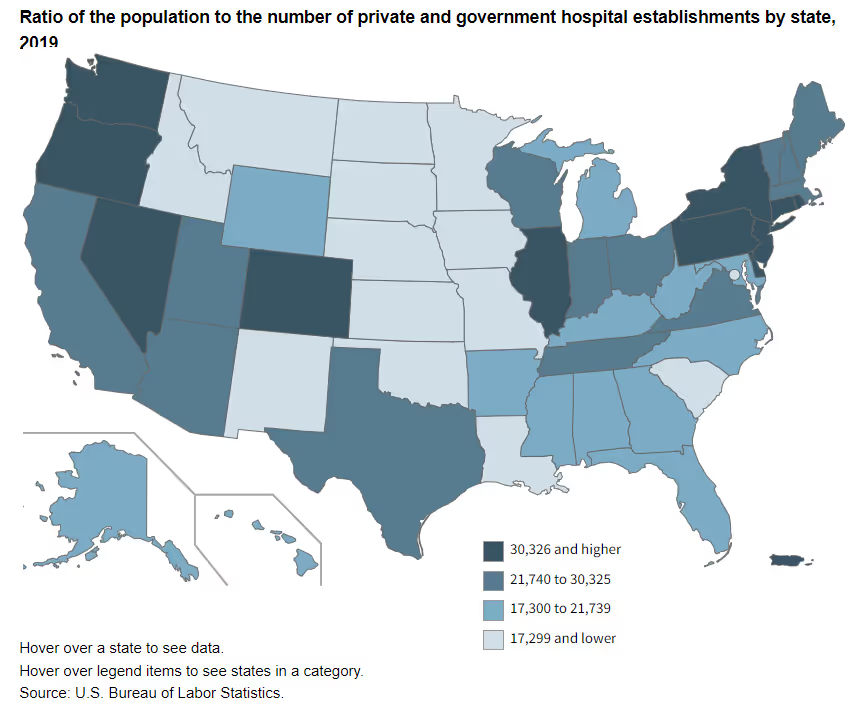U.S. Hospital Statistics & Facts: How Many Are There?


How Many Hospitals Are There In The U.S?
As of 2023, the United States has a total of 6,146 hospitals according to the American Hospital Association (AHA) [1]. These hospitals are diverse in terms of ownership, size, and services offered. In this article, we'll explore some of the most interesting facts and statistics about hospitals in the US.
U.S. Hospital Statistics & Facts
Hospitals in the US can be classified into several types based on their ownership. The AHA data shows that there are 2,849 non-profit hospitals, 1,035 for-profit hospitals, and 1,262 government-owned hospitals in the US. Non-profit hospitals are the most common type, making up 46.4% of all hospitals in the country.

Community hospitals are a crucial part of the US healthcare system, providing essential medical care to millions of Americans. As per AHA data, there are 5,157 community hospitals in the US as of 2023. These hospitals serve both rural and urban areas and provide a wide range of services, from emergency care to specialized treatments.

In terms of ownership, non-government not-for-profit community hospitals are the most common type, accounting for 57.7% of all community hospitals. Investor-owned (for-profit) community hospitals make up 24% of the total number, while state and local government community hospitals account for 18.3%.
It's worth noting that rural communities heavily rely on community hospitals for their healthcare needs. Out of the total number of community hospitals in the US, about 1,800 are located in rural areas. Community hospitals also employ a significant portion of healthcare workers in the country; according to AHA data, they employ more than five million people.

Type of Hospitals
In the US, hospitals offer a range of specialized care for patients. Here are some examples with statistics:
Academic Medical Centers
Approximately 7% of hospitals in the US are academic medical centers. These hospitals provide advanced care for complex cases and often conduct medical research. Examples include Johns Hopkins Hospital in Baltimore, MD and UCLA Medical Center in Los Angeles, CA.
Children's Hospitals
There are 220 pediatric hospitals in the US, including both standalone facilities and those within larger hospital systems. These hospitals provide specialized care for children and often have dedicated pediatric surgery and intensive care units. Examples include Children's Hospital of Philadelphia in Philadelphia, PA and Seattle Children's Hospital in Seattle, WA.
Cancer Treatment Centers
There are more than 1,500 cancer treatment centers in the US. These hospitals specialize in treating cancer patients using advanced technologies such as radiation therapy and chemotherapy. They may also conduct research on cancer prevention and treatment. Examples include Memorial Sloan Kettering Cancer Center in New York, NY and MD Anderson Cancer Center in Houston, TX.
Psychiatric Hospitals
There are approximately 6,000 psychiatric hospitals and residential treatment centers in the US. These facilities provide specialized care for patients with mental health conditions such as depression, bipolar disorder, or schizophrenia. Examples include McLean Hospital in Belmont, MA and Menninger Clinic in Houston, TX.
Rehabilitation Hospitals
There are more than 1,200 rehabilitation hospitals and units in the US. These facilities provide specialized care for patients recovering from injuries or surgeries, with a focus on physical therapy, occupational therapy, and other services to help patients regain function and independence. Examples include Shirley Ryan AbilityLab in Chicago, IL and Kessler Institute for Rehabilitation in West Orange, NJ.
Overall, these hospitals provide essential services to patients with diverse needs across the country. [Source: American Hospital Association]
Size of Hospitals
Hospitals in the US come in a wide range of sizes, from small facilities with just a few beds to large medical centers with thousands of beds. Here's more information on hospital sizes in the US:
Number of Hospital Beds
According to the Centers for Disease Control and Prevention (CDC), the average number of hospital beds per 1,000 people in the US is 2.4. However, this varies widely by state, with some states having as few as 1.6 beds per 1,000 people and others having as many as 4.5 beds per 1,000 people.
Hospital Size Distribution
In the US, there are approximately 6,100 hospitals, including both general medical and surgical hospitals and specialty hospitals such as psychiatric and rehabilitation hospitals. Of these hospitals, about 76% have fewer than 200 beds, while only about 2% have more than 500 beds.
Rural Hospitals
Rural hospitals in the US tend to be smaller than urban hospitals, with an average of 25 beds compared to 146 beds for urban hospitals. However, rural hospitals play a critical role in providing healthcare access to rural communities across the country.

Overall, while hospital size can vary greatly in the US, most hospitals are small to medium-sized facilities with fewer than 200 beds. The number of hospital beds per capita also varies widely by state, indicating differences in healthcare needs and resources across regions. [Sources: CDC, American Hospital Association]
Services Offered by Hospitals
Hospitals in the US provide a broad spectrum of services to meet the healthcare needs of patients. Here's more information on the most common reasons for hospitalization and surgeries in the US:
Reasons for Hospitalization
According to a report by the Healthcare Cost and Utilization Project (HCUP), the most common reason for hospitalization in the US is childbirth, with over 3.7 million deliveries occurring in hospitals annually. Other common reasons for hospitalization include pneumonia, heart failure, sepsis, and chronic obstructive pulmonary disease (COPD).
Most Common Surgeries
The most frequently performed surgeries in US hospitals are cataract surgery, cesarean section, and coronary artery bypass surgery. In 2017, there were approximately 2.7 million cataract surgeries performed, 1.2 million cesarean sections, and 370,000 coronary artery bypass surgeries.
Emergency Department Visits
In addition to hospitalizations and surgeries, emergency departments (EDs) in US hospitals handle a significant volume of patient visits. In 2018, there were approximately 139 million ED visits across the country. The most common reasons for ED visits include abdominal pain, chest pain, back pain, and fever.
Overall, hospitals in the US offer a wide range of services to address various healthcare needs of patients. Childbirth is the leading cause of hospitalization in the US, while cataract surgery, cesarean section, and coronary artery bypass surgery are among the most common surgeries performed in hospitals. Emergency departments also play a critical role in providing immediate medical care to patients in need.
[Sources: HCUP, American Society of Cataract and Refractive Surgery, American College of Obstetricians and Gynecologists]
Impact of Hospitals on the Economy
Hospitals are not only vital for providing healthcare services, but they also have a significant impact on the US economy. Here's more information on the economic contributions of hospitals:
Employment
Hospitals are major employers in the US, providing jobs to over 5.7 million people across the country. This includes physicians, nurses, support staff, and administrative personnel. In fact, hospitals are the largest source of direct healthcare jobs and the second-largest source of overall US employment.

Economic Activity
According to the American Hospital Association (AHA), hospitals generate over $2.8 trillion in economic activity each year. This includes direct spending on healthcare services as well as indirect and induced effects on other sectors of the economy. For every hospital job created, an additional 1.3 jobs are generated in other industries such as retail, construction, and finance.
Community Benefits
In addition to providing healthcare services and creating jobs, hospitals also contribute to their communities in other ways. Nonprofit hospitals are required to provide community benefits in exchange for their tax-exempt status. These benefits can include charity care for low-income patients, community health programs, and investments in medical research and education.
Conclusion
Hospitals in the US are an essential component of the healthcare system, providing medical care to millions of Americans. From community hospitals serving both rural and urban areas to specialized hospitals offering advanced treatments, there is a vast range of facilities available to patients. Hospitals also have a significant impact on the economy, generating employment opportunities and contributing to economic activity. The variety of services offered by hospitals and their economic contributions make them a crucial part of American society.
Sources:
- American Hospital Association. Fast Facts on US Hospitals. Retrieved from https://www.aha.org/statistics/fast-facts-us-hospitals
- Centers for Disease Control and Prevention. Number of All-Care Hospital Beds, 2019. Retrieved from https://www.cdc.gov/nchs/pressroom/nchs_press_releases/2021/20210708.htm
- Healthcare Cost and Utilization Project. Most Common Reasons for Hospitalization, 2017. Retrieved from https://hcup-us.ahrq.gov/reports/statbriefs/sb248-Hospitalizations-United-States-2017.jsp
- Agency for Healthcare Research and Quality. Most Common Operating Room Procedures, 2017. Retrieved from https://www.ahrq.gov/data/fast-facts-2017/operating-room-procedures.html
